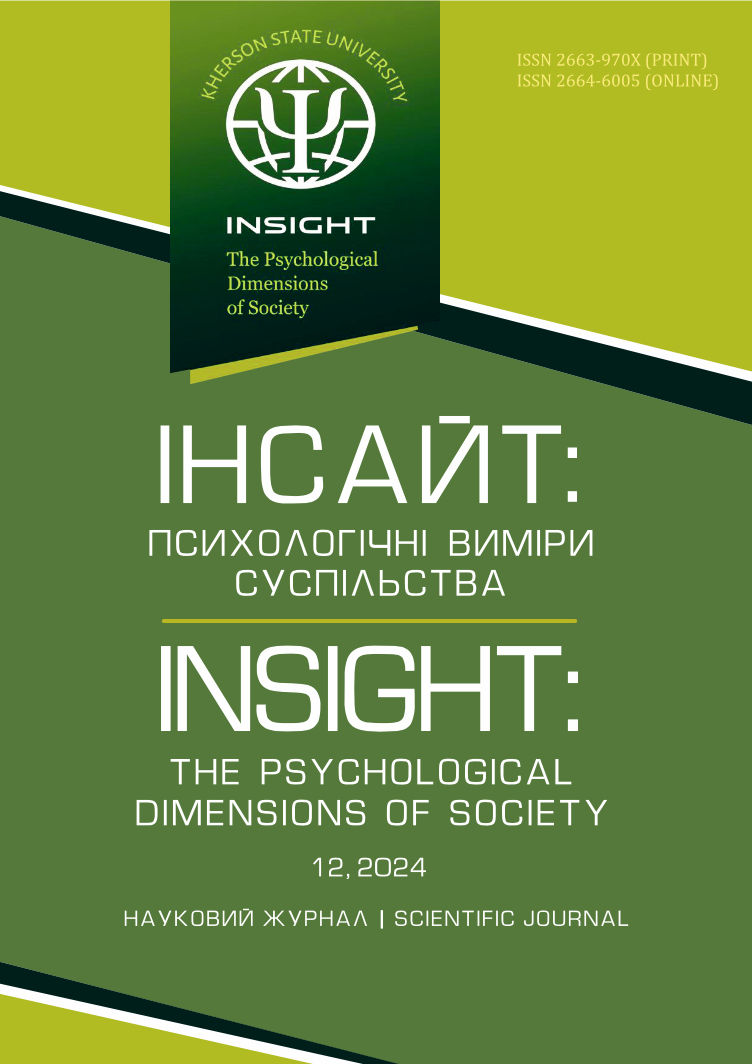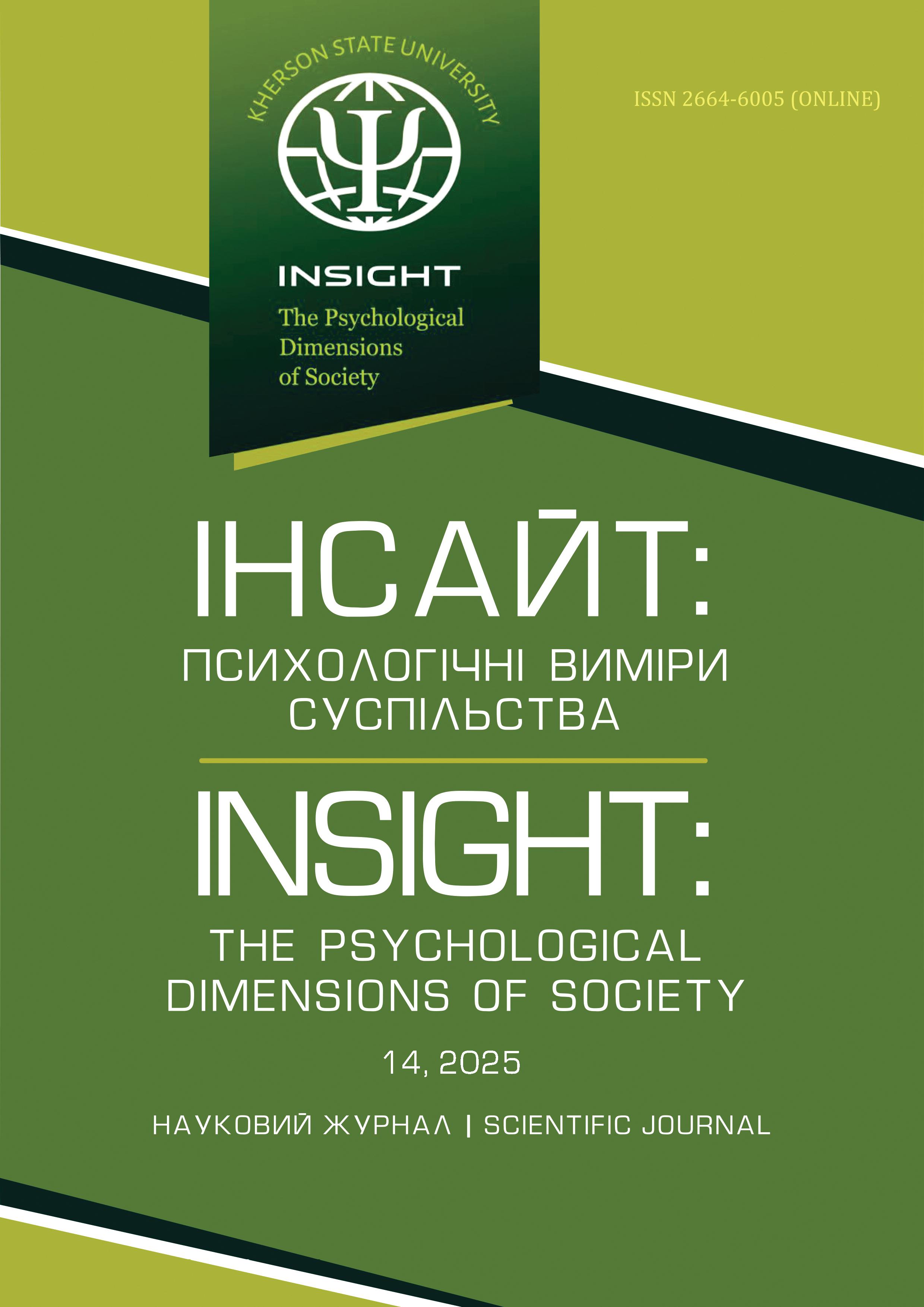Адаптаційний потенціал осіб дорослого віку з розладом дефіциту уваги/гіперактивності (РДУГ)
Анотація
Метою є теоретико-емпіричне дослідження адаптаційного потенціалу осіб дорослого віку з розладом дефіциту уваги/гіперактивності. Методи. Вибіркову сукупність склали особи дорослого віку із РДУГ, загальною кількістю n = 32, з яких жіночої статі – n = 16 (50.00%) і чоловічої – n = 16 (50.00%). Вік досліджуваних знаходився в межах від 20 до 54 років (M = 36.12; Me = 36.00; SD = ± 8.43). Використано теоретико-емпіричний комплекс методів, з яких теоретичні: ретроспективне аналізування, синтезування, порівняння і узагальнення та емпіричні методи: “Шкала робочої та соціальної адаптації” (ШРСА) (Mundt et al., 2002); “Шкала депресії Цунга” (ШДЦ) (Zung, 1965); “Шкала оцінки впливу травматичної події” (ШОВТП) (Sveen et al., 2010); “Шкала оцінки генералізованого тривожного розладу” (GAD-7) (Spitzer et al., 2006; адаптація Н. Алексіна та ін., 2024) і “Нова методика діагностики психосоціальної дезадаптації” (НМДПД) (Herasymenko, 2018). Результати і дискусія. Констатовано, що параметр “робота” володіє всіма статистично достовірними зв’язками з депресивністю, тривожним розладом і типами реагування на травматичну подію (p < .001). Зазначено, що сферою, в якій досліджувані найкомфортніше себе почувають, є “особисте дозвілля”, що зв’язане із захисною реакцією уникання і тривожним розладом. Аргументовано, що уникання як захисний механізм і тип реагування на травматичну подію тільки підвищує схильність до ізольованості й дистантності. Зроблено припущення, що конструктивна організація робочого простору осіб із РДУГ дозволить підвищити адаптаційну спроможність останніх. Висновки. Дослідження адаптаційного потенціалу осіб дорослого віку із РДУГ дозволило з’ясувати достовірні закономірності робочої та соціальної адаптації досліджуваних. Узагальнено, що важливе значення має прийняття й підтримка оточення; толерантність і відсутність стигматизації в родині, в колективі й загалом у суспільстві мають позитивний ефект; ізольованість почасти супроводжується відсутністю підтримки, що може призвести до важких проявів РДУГ і коморбідних розладів; вплив травматичної події позначається на протіканні психічних станів досліджуваних.
Завантаження
Посилання
Adler L. A., Anbarasan D., Leon T., Sardoff T., Descorbeth O., Cho D., Stern Y., Kraft O., Hendler T., Marmar C. R. Pilot Study of Prism EFP NeuroFeedback in Adult ADHD. Journal of Attention Disorders. 2024. Vol. 28(5). P. 905–912. https://doi.org/10.1177/10870547231215283
Ayers-Glassey S., Smilek D. The relations between hyperfocus and similar attentional states, adult ADHD symptoms, and affective dysfunction. Current Psychology. 2024. Vol. 43. P. 11254–11266. https://doi.org/10.1007/s12144-023-05235-3
Bondarchuk O., Balakhtar V., Pinchuk N., Pustovalov I., Pavlenok K. Adaptation of Coping Strategies to Reduce the Impact of Stress and Lonelines on the Psychological Well-Being of Adults. Journal of Law and Sustainable Development. 2023. Vol. 11(10). e1852. https://doi.org/10.55908/sdgs.v11i10.1852
Callen E. F., Clay T., Alai J., Goodman D. W., Adler L. A., Faraone S. V. The Role of Age in Adult ADHD Quality Care: A Longitudinal Analysis of Electronic Health Record Data. Journal of Attention Disorders. 2024. Vol. 28(5). P. 913–922. https://doi.org/10.1177/10870547231218042
Caroline S., S. S., Sudhir P. M., Mehta U. M., Kandasamy A., Thennarasu K., Benegal V. Assessing Adult ADHD: An Updated Review of Rating Scales for Adult Attention Deficit Hyperactivity Disorder (ADHD). Journal of Attention Disorders. 2024. Vol. 28(7). P. 1045–1062. https://doi.org/10.1177/10870547241226654
Dahlan R M. Social Adaptation, Self-Confidence and their Relation to Student Achievement Motivation of Madrasa Senior High School 1 Bogor Indonesia in Generating Student with Character. Opción. 2019. Vol. 35. P. 841–863. URL: https://produccioncientificaluz.org/index.php/opcion/article/view/29670
Danielson M. L., Claussen A. H., Arifkhanova A., Gonzalez M. G., Surman C. Who Provides Outpatient Clinical Care for Adults With ADHD? Analysis of Healthcare Claims by Types of Providers Among Private Insurance and Medicaid Enrollees. Journal of Attention Disorders. 2024. Vol. 28(8). P. 1225–1235. https://doi.org/10.1177/10870547241238899
Enriquez‐Urzelai U., Palacio A. S., Merino N. M., Sacco M., Nicieza A. G. Hindered and constrained: limited potential for thermal adaptation in post‐metamorphic and adult Rana temporaria along elevational gradients. Journal of Evolutionary Biology. 2018. Vol. 31(12). P. 1852–1862. https://doi.org/10.1111/jeb.13380
First J. M., Yu M., Houston J. B. The Disaster Adaptation and Resilience Scale: development and validation of an individual-level protection measure. Disasters. 2021. Vol. 45(4). P. 939–967. https://doi.org/10.1111/disa.12452
Fullerton D. J., Zhang L. M., Kleitman S. An Integrative Process Model of Resilience in an Academic Context: Resilience Resources, Coping Strategies, and Positive Adaptation. Plos One. 2021. Vol. 16. e0246000. https://doi.org/10.1371/journal.pone.0246000
Herasymenko L. А. A new method of diagnosis of psychosocial maladjusment. Likars’ka Sprava. 2018. Vol. 1–2. P. 82–88. https://doi.org/10.31640/JVD.1-2.2018(14)
Hrys A., Popovych I., Zelenko O., Pavliuk M., Fedorenko L., Prachenko O., Huzar V. Time decentrations of junior athletes under changed conditions of competitive activity. Journal of Physical Education and Sport. 2024. Vol. 24(1). P. 13–22. https://doi.org/10.7752/jpes.2024.01002
Hutt Vater C., DiSalvo M., Ehrlich A., Parker H., O’Connor H., Faraone S. V., Biederman J. ADHD in Adults: Does Age at Diagnosis Matter? Journal of Attention Disorders. 2024. Vol. 28(5). P. 614–624. https://doi.org/10.1177/10870547231218450
Jakobsson Støre S., Van Zalk N., Granander Schwartz W., Nilsson V., Tillfors M. The Relationship Between Social Anxiety Disorder and ADHD in Adolescents and Adults: A Systematic Review. Journal of Attention Disorders. 2024. Vol. 28(9). P. 1299–1319. https://doi.org/10.1177/10870547241247448
Jen-Yi L., Krishnasamy M., Der-Thanq C. Research with persons with intellectual disabilities: An inclusive adaptation of Tourangeau’s model. Alter. 2015. Vol. 9(4). P. 304–316. https://doi.org/10.1016/j.alter.2015.07.006
Katzman M. A., Bilkey T. S., Chokka P. R., Fallu A., Klassen L. J. Adult ADHD and comorbid disorders: clinical implications of a dimensional approach. BMC psychiatry. 2017. Vol. 17. Article number: 302. https://doi.org/10.1186/s12888-017-1463-3
Knouse L. E., Mitchell J. T. Incautiously Optimistic: Positively-Valenced Cognitive Avoidance in Adult ADHD. Cognitive and Behavioral Practice. 2015. Vol. 22(2). P. 192–202. https://doi.org/10.1016/j.cbpra.2014.06.003
Кокун О. М. Оптимізація адаптаційних можливостей людини: психофізіологічний аспект забезпечення діяльності. Київ: Міленіум. 2004. 265 с. URL: https://lib.iitta.gov.ua/id/eprint/1513
Kroenke K., Spitzer R. L., Williams J. B. The PHQ-9: validity of a brief depression severity measure. Journal of General Internal Medicine. 2001. Vol. 16(9). P. 606 – 613. https://doi.org/10.1046/j.1525-1497.2001.016009606.x
Krtkova R., Krtek A., Pesoutova M., Meier Z., Tavel P., Malinakova K., Trnka R. What influences do parents perceive as supportive of school well-being and the inclusion of children with ADHD?: A qualitative study. European Journal of Special Needs Education. 2022. Vol. 38(2). P. 218–232. https://doi.org/10.1080/08856257.2022.2050972
Maksymova N. Y., Hrys A., Pavliuk M. M., Maksymov M. V., Ivantsev N. I. Environmental Friendliness of a Person’s Musical Space as a Factor of Personality Disharmony Prevention. Journal of Intellectual Disability – Diagnosis and Treatment. 2021. Vol. 9(6). P. 667–675. https://doi.org/10.6000/2292-2598.2021.09.06.9
Mattos P., Moraes C. E. F. de Sichieri R., Hay P., Faraone S. V., Appolinario J. C. Adult ADHD Symptoms in a Large Metropolitan Area from Brazil: Prevalence and Associations with Psychiatric Comorbidity, Bullying, Sexual Abuse, and Quality of Life. Journal of Attention Disorders. 2024. Vol. 28(7). P. 1082–1091. https://doi.org/10.1177/10870547241229097
Mundal I., Schei J., Lydersen S., Thomsen P. H., Novik T. S., Kvitland L. R. Prevalence of chronic and multisite pain in adolescents and young adults with ADHD: a comparative study between clinical and general population samples (the HUNT study). European Child & Adolescent Psychiatry. 2024. Vol. 33. P. 1433–1442. https://doi.org/10.1007/s00787-023-02249-x
Mundt J. C., Marks I. M., Shear M. K., Greist J. H. The Work and Social Adjustment Scale: a simple measure of impairment in functioning. British Journal of Psychiatry. 2002. Vol. 180. P. 461–464. https://doi.org/10.1192/bjp.180.5.461
Nagatsuka Y., Nakamura D., Ota M., Arai G., Iwami Y., Suzuki H. Gaze measurements during viewing human dialogue scenes in adults with ADHD: Preliminary findings. Neuropsychopharmacology Reports. 2024. Vol. 44. P. 73–79. https://doi.org/10.1002/npr2.12383
Ogrodnik M., Karsan S., Malamis B., Kwan M., Fenesi B., Heisz J. J. Exploring Barriers and Facilitators to Physical Activity in Adults with ADHD: A Qualitative Investigation. Journal Developmental and Physical Disabilities. 2023. Vol. 36. P. 307–327 (2024). https://doi.org/10.1007/s10882-023-09908-6
Olesen E. Overcoming Diagnostic Uncertainty: Clinicians, Patients and Institutional Work in Practice. Scandinavian Journal of Disability Research. 2019. Vol. 21(1). P. 186–196. https://doi.org/10.16993/sjdr.638
Пінас Н., Грись, А. Соціально-психологічні чинники адаптації осіб дорослого віку із РДУГ. Наукові праці Міжрегіональної Академії управління персоналом. Психологія. 2024. № 1(62). С. 15–24. https://doi.org/10.32689/maup.psych.2024.1.3
Park S., Park S. Prevalence, Correlates, and Comorbidities Among Young Adults Who Screened Positive for ADHD in South Korea During the COVID-19 Pandemic. Journal of Attention Disorders. 2024. Vol. 28(9). P. 1331–1339. https://doi.org/10.1177/10870547241253151
Pedersen A. B., Edvardsen B. V., Messina S. M., Volden M. R., Weyandt L. L., Lundervold A. J. Self-Esteem in Adults with ADHD Using the Rosenberg Self-Esteem Scale: A Systematic Review. Journal of Attention Disorders. 2024. Vol. 28(7). P. 1124–1138. https://doi.org/10.1177/10870547241237245
Popovych I., Hrys A., Hoian I., Mamchur I., Babenko A., Fedyk O. Successfulness in teenagers’ sporting activities: comparative analysis of individual and team sports. Journal of Physical Education and Sport. 2022a. Vol. 22(11). P. 2886–2897. https://doi.org/10.7752/jpes.2022.11365
Popovych I., Kosmii M., Hrys A., Hoi N., Dyhun I., Hoian I., Nosov P. Pre-competition expectation profiles among junior athletes in the context of altered sporting conditions. Journal of Physical Education and Sport. 2023. Vol. 23(10). P. 2551–2562. https://doi.org/10.7752/jpes.2023.10293
Popovych I., Kurova A., Koval I., Kazibekova V., Maksymov M., Huzar V. Interdependence of emotionality, anxiety, aggressiveness and subjective control in handball referees before the beginning of a game: a comparative analysis. Journal of Physical Education and Sport. 2022b. Vol. 22(3). P. 680–689. https://doi.org/10.7752/jpes.2022.03085
Popovych I. S., Blynova O. Ye. The Structure, Variables and Interdependence of the Factors of Mental States of Expectations in Students’ Academic and Professional Activities. The New Educational Review. 2019. Vol. 55(1). P. 293–306. https://doi.org/10.15804/tner.2019.55.1.24
Popovych I., Zavatskyi V., Tsiuniak O., Nosov P., Zinchenko S., Mateichuk V., Zavatskyi Yu., Blynova O. Research on the Types of Pre-game Expectations in the Athletes of Sports Games. Journal of Physical Education and Sport. 2020. Vol. 20(1). P. 43–52. https://doi.org/10.7752/jpes.2020.01006
Prokhorenko L., Popovych I., Sokolova H., Chumaieva Yu., Kosenko Yu., Razumovska T., Zasenko V. Gender differentiation of self-regulating mental states of athletes with disabilities: comparative analysis. Journal of Physical Education and Sport. 2023. Vol. 23(2). P. 349–359. https://doi.org/10.7752/jpes.2023.02042
Richard V., Lebeau J.-C., Becker F., Inglis E. R., Tenenbaum G. Do more creative people adapt better? An investigation into the association between creativity and adaptation. Psychology of Sport and Exercise. 2018. Vol. 38. P. 80–89. https://doi.org/10.1016/j.psychsport.2018.06.001
Selye H. A. Confusion and Controversy in the Stress Field. Journal of Human Stress. 1975. Vol. 1. Р. 37–44. http://dx.doi.org/10.1080/0097840X.1975.9940406
Shcherbak T., Popovych I., Kariyev A., Duisenbayeva A., Huzar V., Hoian I., Kyrychenko K. Psychological causes of fatigue of football players. Journal of Physical Education and Sport. 2023. Vol. 23(8). P. 2193–2202. https://doi.org/10.7752/jpes.2023.08251
Spitzer R. L., Kroenke K., Williams J. B. W., Löwe B. A Brief Measure for Assessing Generalized Anxiety Disorder: The GAD-7. Archives of Internal Medicine. 2006. Vol. 166(10). P. 1092–1097. https://doi.org/10.1001/archinte.166.10.1092
Sprich S. E., Knouse L. E., Cooper-Vince C., Burbridge J., Safren S. A. Description and Demonstration of CBT for ADHD in Adults. Cognitive and Behavioral Practice. 2010. Vol. 17(1). P. 9–15. https://doi.org/10.1016/j.cbpra.2009.09.002
Sveen J., Low A., Dyster-Aas J., Ekselius L., Willebrand M., Gerdin B. Validation of a Swedish version of the Impact of Event Scale-Revised (IES-R) in patients with burns. Journal of Anxiety Disorders. 2010. 24(6). P. 618–622. https://doi.org/10.1016/j.janxdis.2010.03.021
Tkalych M. H. Psychoemotional states and vitality: psychological adaptation during wartime. In: Psychological patterns of social processes and personality development in modern society: Scientific monograph. Riga, Latvia: “Baltija Publishing”, 2023. P. 230–243. https://doi.org/10.30525/978-9934-26-326-2-13
Waldren L. H., Leung F. Y. N., Hargitai L. D., Burgoyne A. P., Liceralde Van R. T., Livingston L. A., Shah P. Unpacking the overlap between Autism and ADHD in adults: A multi-method approach. Cortex. 2024. Vol. 173. P. 120–137. https://doi.org/10.1016/j.cortex.2023.12.016
Wang Y.-H., Gau S.-F., Yang L.-K., Chang J.-C., Cheong P.-L., Kuo H.-I. Acute aerobic exercise at different intensities modulates inhibitory control and cortical excitability in adults with attention-deficit hyperactivity disorder (ADHD). Asian Journal of Psychiatry. 2024. Vol. 95. P. 103993. https://doi.org/10.1016/j.ajp.2024.103993
Zung W. W. A self-rating depression scale. Archives of General Psychiatry. 1965. Vol. 12, 63–70. https://doi.org/10.1001/archpsyc.1965.01720310065008
Автори, які публікуються у науковому журналі, погоджуються з наступними умовами:
· Всі наукові праці можуть вільно копіюватися і поширюватися на будь якому носії і в будь якому форматі, за умови зазначення покликань на вихідні дані наукової праці.
· Автори залишають за собою право на авторство своєї роботи та передають журналу право першої публікації цієї роботи на умовах ліцензії Creative Commons Attribution License.
· Автори мають право укладати самостійні додаткові угоди щодо неексклюзивного розповсюдження роботи у тому вигляді, в якому вона була опублікована цим журналом (інституційний репозитатрій, особистий веб-сайт, монографія), здійснивши первинне покликання на публікацію роботи в цьому журналі.




































